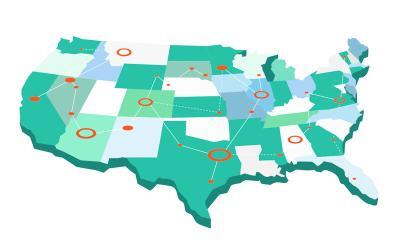Maintaining an exceptional staff reigns as one of the essential ingredients for a successful restaurant. With hiring that staff, comes payroll responsibilities and complying with all related federal, state, and local employment and tax laws.
Payroll for restaurants is complex. It entails calculating work hours, wages, salaries, benefits, and wage garnishments; withholding and paying employment-related taxes; reporting and remitting withholdings to the appropriate agencies; and dealing with the nuances of handling tipped employees’ compensation and tax withholdings. The percentage of revenue a restaurant should expect to spend on payroll varies depending on the type of establishment. Fast-food restaurants usually spend less than higher-end, fine-dining eateries. Generally, 25% to 35% is the norm.
In today’s post, I’ll walkthrough what you need to know to maintain compliance and keep your costs down.
Steps for Setting up Payroll for Your Restaurant
Before administrating payroll, restaurants must prepare. I’ve listed the basic steps involved below. Your restaurant may have to fulfill other requirements depending on your location and the laws there.
- Consider forming an LLC or Corporation for your eating establishment – While not required, registering a business as a Limited Liability Company or Corporation helps protect the business owner’s personal assets. Moreover, it may provide some tax advantages and flexibility. For instance, an eligible LLC or C Corporation can elect to be treated as an S Corporation for tax purposes.
- Obtain an EIN – An EIN is the federal tax ID number for withholding and reporting federal employment taxes.
- Set up a payroll bank account – You may find it beneficial to have a separate account for payroll purposes rather than use your restaurant’s primary business bank account for payroll expenses.
- Determine the method for paying employees – Among the possible options are a paper check, direct deposit, pay cards, or mobile wallet. Some states require employers to pay employees by direct deposit into workers’ bank accounts, which involves obtaining employees’ bank account numbers and their banks’ routing numbers.
- Register for state payroll tax – State payroll tax registration is required for withholding, reporting, and remitting state payroll taxes. Some states also require getting a separate unemployment tax ID. Depending on where your restaurant is located, you might also have to register for a local payroll tax ID.
- Determine your restaurant’s payroll schedule – Some states may have specific frequencies for paying employees. Options might include weekly, bi-weekly, semi-monthly, or monthly.
- Purchase workers’ compensation insurance – A workers’ comp policy compensates employees who are injured or become ill because of their work activities.
- Prepare to obtain required documentation from employees – This will include a W-4 form to document their filing status and track personal allowances to determine the percentage of payroll taxes to be withheld from their paychecks. Some states have their own forms to determine state-mandated withholdings. Restaurants must also have employees complete Form I-9, Employment Eligibility Verification, to document that each new employee (citizen and noncitizen) hired is authorized to work in the United States.
- Decide whether you’ll handle your own payroll activities or get professional assistance – Consider this carefully! A lot can go wrong if you calculate payroll incorrectly, miss reporting and payment due dates, or otherwise fail to handle it properly. Payroll software can help, and many businesses find it helpful to have their payroll managed by a payroll company or accounting firm if they don’t have that specialized knowledge in-house.
Restaurant Payroll Taxes and Withholdings
Restaurants with employees must register to pay payroll taxes in their state. If a restaurant has locations in multiple states, it must register to withhold, report, and pay taxes in each state where it has employees. Rules may vary depending on the state, so it’s important to research the requirements and get guidance from an accounting or payroll specialist if you’re unclear about your responsibilities.
Below is a list of employment-related taxes that restaurants may have to withhold or pay:
- Federal income tax – Restaurants must withhold federal income tax from employee pay based on an employee’s taxable wages and tip income and the allowances the worker selected on their W-4 form.
- State income tax – Restaurants must withhold state income tax from employee pay based on a worker’s taxable wages and tip income. Some states, but not all, have allowances to reduce the tax withheld.
- Local income tax – Restaurants must withhold local income tax from employee pay based on a worker’s taxable wages and tip income.
- FICA – Restaurants must withhold half of their employees’ Social Security and Medicare Taxes from their workers’ pay, and the restaurant must pay the other half. Learn more about FICA.
- State and local payroll taxes – Some might be paid directly by the restaurant while others might be withheld from employees’ pay – the rules vary by state and local jurisdiction.
- Federal unemployment tax – Restaurants pay the FUTA tax. No portion of FUTA may be withheld from employees’ paychecks.
- State unemployment tax – SUTA (or SUI) is usually paid by employers and not withheld from employee paychecks.
- Workers’ compensation insurance – This cost is paid by the restaurant and not deducted from employee paychecks.
- Employee wage garnishments – Restaurants must withhold wage garnishments — such as for alimony, child support, and unpaid taxes — from employees’ paychecks.
- Benefits and other voluntary deductions – There may be other deductions restaurants withhold from employees’ pay — such as 401K contributions, medical insurance plan premiums, health savings plan contributions, and others.
How to Calculate a Restaurant Employee’s Take-Home Pay
Payroll calculations involve the following elements:
- Gross Pay – Restaurants must calculate their employees’ gross pay according to their hourly wage (or salary) and any tips received. Gross pay also includes bonuses earned by employees.
- Pre-Tax Deductions – Any deductions not subject to tax, such as 401K contributions and medical insurance premiums, should be subtracted from gross pay.
- Tax Deductions – After subtracting pre-tax deductions from gross pay, the restaurant should deduct taxes from the adjusted amount.
- Other Deductions – Next, the restaurant should subtract any additional voluntary or court-ordered deductions — e.g., court-ordered wage garnishments, Roth 401K contributions, and charitable contributions.
- Net Pay – The money remaining is the employee’s net (take-home) pay.
Managing Tips and Payroll
According to the U.S. Department of Labor, tipped employees are those engaged in an occupation that regularly receives over $30 per month in tips. Examples of tipped restaurant employees include servers, bartenders, bus people, barbacks, and baristas.
The employer of a tipped employee is only required to pay $2.13 per hour in direct wages if that amount, plus the tips received, equals or exceeds the federal minimum wage. The employer must make up the difference if the direct wages and tips do not equal or exceed the federal minimum hourly wage. Some states require employers to pay direct wage amounts higher than the federal minimum to tipped employees.
All tips received by employees — whether cash or checks received directly from customers, paid over to the employee from tips charged on credit or debit cards, or received from other employees through a tip-sharing arrangement — are taxable under the law. Employees must also record the value of non-cash tips (e.g., event tickets, gift cards, etc.)
Restaurants must factor tip income into their payroll deductions from employees’ pay. They must retain their employees’ tip reports, withhold income taxes and the employee’s share of Social Security and Medicare taxes based on their wages and tip income, and remit those taxes to the government. Restaurants must also pay the employer’s share of the Social Security and Medicare taxes on their employees’ wages and reported tips.
Important note: When a restaurant adds service charges or automatic gratuities to a customer’s bill, they are considered business revenue, not employee tips. If the restaurant divides those monies among its staff, they must be treated as wages, not tips.
Why Restaurant Employees Should Report All of Their Tips
Although servers, bartenders, bussers, and other tipped employees may feel tempted to under-report their tip income, it’s important they do because it’s illegal not to.
Restaurant owners and managers can encourage their employees to report all of their tips by sharing the advantages of doing so. The more tip money an employee reports…
- The more Social Security benefits they’ll be eligible for when they retire.
- The more money they can contribute to their employer-provided 401K plan.
- The more money they will receive in unemployment benefits if they lose their job through no fault of their own.
- The more workers’ compensation benefits they can receive if they are injured on the job.
- The more easily they may qualify for a loan or line of credit.
Let restaurant employees know that if they must share their tips with other employees (for example, servers sometimes give some of their tips to bartenders and bus people), only the tip amount they keep is taxable to them. The other employees who received a portion of an employee’s tips must report the amount they received.
A quick word about tip-pooling: Typically, tip sharing is allowed among staff with direct contact with customers and who are getting paid less than minimum wage in their wages — such as servers and bartenders. However, if a restaurant owner pays workers the full minimum wage or more, they may pool employees’ tips and distribute them to all employees according to a defined policy. So, back-of-house employees (e.g., chefs and dishwashers) also get a portion of the front-house tips.
As you can imagine, workers may find it daunting to track their tips. Fortunately, the IRS offers some resources to encourage compliance with tip-reporting rules and make it easier for employees to keep accurate tip records.
- The IRS Tip Rate Determination/Education Program (TRD/EP) – This voluntary program offers two agreement-based options: 1) Tip Rate Determination Agreement (TRDA) and 2) Tip Reporting Alternative Agreement (TRAC). Both help restaurants get employees to report their income accurately and minimize lengthy IRS examinations. The IRS offers more information about the program in Publication 3144, A Guide to Tip Income Reporting for Employers in Businesses Where Tip Income is Customary.
- Publication 1244, Employee’s Daily Record of Tips and Report to Employer – This booklet serves as a reporting tool to keep track of tips. It Includes two forms — 4070A (Employee’s Daily Record of Tips) and 4070 (Employee’s Report of Tips to Employer).
Forms for Reporting Restaurant Employee Wages and Tips
- IRS Form 4070A for Employee’s Daily Record of Tips – Employees may use form 4070A or an alternate record-keeping document to record the tips they receive during their work shifts.
- IRS Form 4070 for Employee’s Report of Tips to Employer – Employees must report their tips received in a month to the restaurant by the 10th of the month after the month the employee received the tips. Employees may use this form to report their tip income (cash, credit card, and amounts paid to them from other employees) to the restaurant if they earn $20 or more in tips during the month. Or they can use a similar form of documentation as long as it contains the same information requested on Form 4070:
- Employee signature,
- Employee’s name, address, and social security number,
- Employer’s name and address (establishment name if different),
- Month or period the report covers, and
- Total of tips received during the month or period.
- IRS Form 4137 for Social Security and Medicare Tax on Unreported Tip Income – Employees use form 4137 to report and pay their share of Social Security and Medicare taxes on tips they didn’t report to the restaurant.
- IRS Form 8027 for Employer’s Annual Information Return of Tip Income and Allocated Tips – If a restaurant is considered a large food or beverage establishment, it must file this form each year. Responsibility for submitting this form comes when a restaurant meets all of the below criteria:
- It is located in the 50 states or the District of Columbia,
- It provides food or beverages for consumption on the premises (excluding fast food operations),
- Tipping by customers is customary,
- It regularly had more than 10 employees on a typical business day during the prior calendar year.
- IRS Form 941 for Employer’s QUARTERLY Federal Tax Return – Restaurants must report income tax, Social Security tax and Medicare taxes withheld from their employees’ wages (including tips), and the employer’s share of Social Security and Medicare taxes on Form 941. They must then deposit those monies according to federal requirements.
- IRS Form 940 for Employer’s Annual Federal Unemployment (FUTA) Tax Return – Most restaurants must also file Form 940 to report and pay FUTA tax on employees’ wage and tip income. The restaurant pays FUTA tax; no money is withheld from employees’ paychecks.
- IRS Form W-2 for Wage and Tax Statement – Restaurants must provide a W-2 form at the end of the tax year to each employee to whom they paid $600 or more or whose compensation (regardless of the amount) had income taxes, Social Security tax, or Medicare tax withheld.
A large food or beverage restaurant must allocate tips if the total tips an employee reported during any payroll period are less than that employee’s share of 8% of the business’s food and drink sales. There are various methods of allocating tips, so consider talking with an accounting professional to discuss which option will work best in your situation. Tips allocated to employees should be shown on the worker’s Form W-2, Wage and Tax Statement.
What Happens If Employees Don’t Report Their Tips?
Not reporting tips could mean the employee will have to pay back taxes and penalties (up to 50% of the FICA taxes and 20% of the income taxes they owe on tips). They might even have to pay interest for all the years they didn’t report their tips truthfully.
A restaurant is not required to withhold or pay the employee’s share of Social Security and Medicare taxes on unreported tips. It must, however, pay the employer’s share of those taxes when the IRS issues a Section 3121(q) Notice and Demand.
Options for Managing Your Restaurant Payroll
While restaurant owners may consider handling payroll tasks themselves, things can go awry if they don’t have knowledge in-house about all the rules or if they don’t have adequate time amid their other duties to devote the time required to do it accurately.
At face value, the DIY approach may seem like a money-saver. But ultimately, it can become more costly if they get penalized because of missing reporting deadlines, failing to calculate wages or withholdings correctly, or not making deposits on time.
Using payroll software can help immensely because it’s specially designed to calculate income and withholdings, manage benefits, collect and store forms, and streamline other aspects of the process.
Another option is to outsource payroll tasks to an accounting firm, bookkeeper, or payroll solutions provider who understands all aspects of the payroll process and uses reliable payroll software to ensure accuracy and efficiency.
Additional Considerations
- Look for a good employee time and attendance system to accurately track employee hours, wages, and any movement between different shifts or job positions (particularly if the wages vary depending on the shift work or the job performed).
- Generally, a tip (whether cash or left on a credit card) is the property of the employee to whom it was given. However, some states allow restaurants to subtract credit card processing fees from charged tips.
- Maintain payroll records for the required. While the IRS requires employment-related tax records to be kept for four years, it’s not uncommon for businesses to hold on to them for seven years to cover state and federal statutes of limitations.
- Besides payroll-related regulations, restaurant owners must also comply with other hiring and employment laws. Several include:
Administrating payroll can be a time-consuming, intensive process that demands knowing and complying with all federal, state, and local tax laws. If your restaurant doesn’t have in-house staff with the time and expertise to do it right, seek the professional help you need to handle payroll lawfully and accurately.
CorpNet’s Here to Help You Get Cooking!
With a team of experts experienced in registering businesses for state payroll in all 50 states, your restaurant is in capable hands no matter where you’re located.





